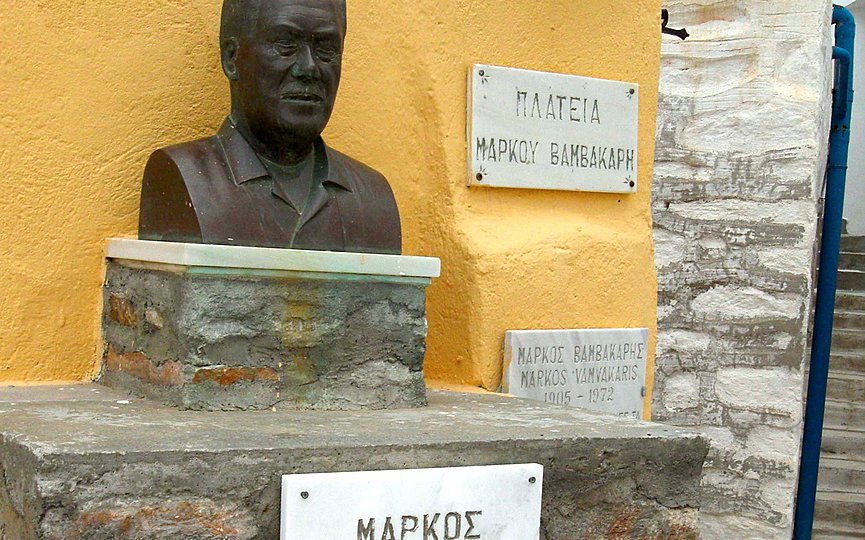General News
Meropi Kyriacou Honored as TNH Educator of the Year
NEW YORK – Meropi Kyriacou, the new Principal of The Cathedral School in Manhattan, was honored as The National Herald’s Educator of the Year.

May 10th:
On this day in 1905, Markos Vamvakaris, the Greek rebetiko musician and songwriter, was born on the island of Syros. The first of six children, Markos and his family belonged to the sizable Roman Catholic community of the island. At the age of 12, under the false impression that he was wanted by the police, Markos fled Syros for the port of Piraeus. He worked as a stevedore, a pit-coal miner, a shoe-polisher, a paperboy, a butcher, and other odd jobs. It is said that one day he heard a bouzouki player and vowed that if he did not learn to play the instrument in six months, he would chop off his own hand with a cleaver (he was working in the public slaughterhouses at the time). He learned bouzouki, becoming an innovative virtuoso player, and began to write songs of his own. At first he often played in clandestine hashish-smoking establishments known as tekés; later he and his bands played in more legitimate clubs and taverns. They were extremely popular, and Markos made many recordings. Today, he is universally referred to by rebetiko writers and fans simply by his first name: Markos. The great significance of Vamvakaris for the rebetiko is reflected by his nickname: the "patriarch of the rebetiko."
May 11th:
On this day in 1771, Laskarina Bouboulina, the Greek naval commander and heroine of the Greek War of Independence of 1821, was born in a prison in Constantinople and was immediately part of a revolutionary family. After her father died, Bouboulina and her mother moved to the Greek island of Hydra and then on to Spetses. She was married and widowed twice and was left considerable fortunes by her sea-faring husbands. Through wise investments she increased her worth and bought several ships, including the Agamemnon, the largest warship in the 1821 revolution against the Turks. Bouboulina became a member of the underground organization, Filiki Etairia (the Friendly Society) organizing and preparing the Greeks for the revolution against the Turks, the only woman in this organization. On March 13, 1821, twelve days before the official beginning of the War of Independence, Bouboulina raised the first revolutionary flag on the island of Spetses. Bouboulina was killed on May 22, 1825, by a bullet wound to her head – presumably fired by the angry father of her daughter-in-law (who had eloped with her son). She became a national hero, one of the first women to play a major role in a revolution. Without her and her ships the Greeks might not have gained their independence.
May 13th:
On this day in 1995, a 6.6 magnitude earthquake rocked Northern Greece and severely damaged about 5000 houses, churches, and schools in the Kozani and Grevena prefectures. Fortunately, there were no recorded fatalities and only about 20 light injuries were reported (this could be because there was a foreshock a few minutes before that forced residents to move out of their houses). It was the largest earthquake in Greece in the decade leading up to the catastrophic event. The earthquake was unexpected in the sense that the epicentral region was assumed to be of low seismic risk. The main shock was preceded by several foreshocks and followed by intense aftershock activity that lasted several months. Greece experiences the highest seismicity in western Europe.
May 14th:
On this day in 1962, Princess Sophia of Greece married Don Juan Carlos of Spain. Princess Sophia was born on November 2, 1928 in Psychiko, Athens, the eldest child of King Paul of Greece and his wife, Queen Frederica. She studied childcare, music, and archeology and was a reserve member, alongside her brother Constantine, of Greece’s gold medal-winning sailing team in the 1960 Summer Olympics. Sophia met her paternal third cousin (they are both descendants of Queen Victoria of England), Juan Carlos of Spain, on a cruise in the Greek islands in 1954 and then reconnected with him at the wedding of the Duke of Kent in 1961. The couple was married in Athens in three separate ceremonies: at the Roman Catholic Cathedral of Saint Dionysius; at the Greek Orthodox Metropolitan Cathedral of the Virgin Mary; and at the Royal Palace in Athens (a civil union ceremony). Sophia converted from Greek Orthodoxy to Roman Catholicism to become more palatable to Catholic Spain, and thus relinquished her rights to the Greek throne. Along with this came the expected Latinization of her Greek name from Sophia, to the Spanish variant, Sofia. The couple ruled over Spain for 29 years and had three children: Elena, Cristina, and Felipe.
NEW YORK – Meropi Kyriacou, the new Principal of The Cathedral School in Manhattan, was honored as The National Herald’s Educator of the Year.

RAFAH, Gaza Strip (AP) — Sabreen Jouda came into the world seconds after her mother left it.
NEW YORK — Monday's opening statements in the first criminal trial of a former American president provided a clear roadmap of how prosecutors will try to make the case that Donald Trump broke the law, and how the defense plans to fight the charges on multiple fronts.
ASTORIA – The singer Anastasia visited St.
CHICAGO, IL – This spring, Wrightwood 659 hosts Chryssa & New York, the first museum exhibition in North America in more than four decades to focus on the Greek-born artist Chryssa (1933–2013).
NEW YORK – Greek-American George Patrikis, owner of Ditmars Flower Shop in Astoria, was featured in the New York Times on April 15 about the rise in the cost of a dozen red roses from $60 in 2019 to $72 today.